According to many psychiatrists and brain experts, about one in 10 autistic children sheds symptoms before adulthood. Duke researcher Geraldine Dawson explains that "there is this subgroup of kids who start out having autism and then, through the course of development, fully lose those symptoms." Now they just have to figure out why. From the NYT Magazine: The Kids Who Beat Autism.
Entries for July 2014 (August 2014 » • September 2014 » • October 2014 » • Archives)
The kids who beat autism
Roasting Richard Pryor
Hi, everybody! Tim Carmody here, guest-hosting for Jason this week.
I love Richard Pryor. If you don't know why, read Hilton Als's 1999 profile of Pryor in The New Yorker right after you watch 1979's Live In Concert. Everything Eddie Murphy did in the '80s, Chris Rock did in the '90s, Dave Chappelle did in the '00s, or Louis CK's done over the last decade is all there in Pryor. Stand-up comedy is a series of footnotes to Richard Pryor in the same way Western philosophy is a series of footnotes to Plato.
But Pryor was uncompromising and self-destructive, a common combination to breakthrough talents but deadly to life, limbs, and careers. His 1977 television series was at least twenty-five years ahead of everything on TV (and it aired in prime-time on NBC) but was pulled from the air after Pryor refused to cooperate with the network's changes. He filmed just four episodes.
For the last episode, Richard was roasted by the cast of the show and a few special guests. The roasters include a very young Robin Williams and Sandra Bernhardt, longtime Pryor collaborator Paul Mooney, and very funny performances by Tim Reid (Venus Flytrap from WKRP in Cincinatti) and a young and frankly stunning Marsha Warfield (Roz from Night Court).
The unedited roast was never broadcast, for reasons that'll be obvious. It's raucous but more or less clean until Richard gets up to respond and lays them the fuck out. It is glorious.
Do not step to Richard Pryor. He takes it straight to eleven. And you love him anyway.
Hawkeye's hearing, or How to use signs in storytelling
Hi, everybody! Tim Carmody here, guest-hosting for Jason this week.
In the Marvel comic Hawkeye #15, published in February, the title character was brutally attacked and deafened by a supervillain real estate developer trying to push the hero's neighbors out of their apartment building in Brooklyn's Bed-Stuy. (It's a very special comic book.) This week's issue, #19, took months to finish but finally picks up that story line. It's mostly told in a combination of silent panels, American Sign Language, and half-intelligible lip reading. It's already being talked about as a shoo-in for this year's Eisner award for best single issue.

There are precedents here. Last year's mostly-silent Hawkeye #11 was told from the point of view of a dog (named Pizza Dog), using symbols and maps to tell a kind of detective story. (That issue also won writer Matt Fraction and artist David Aja the Eisner.)
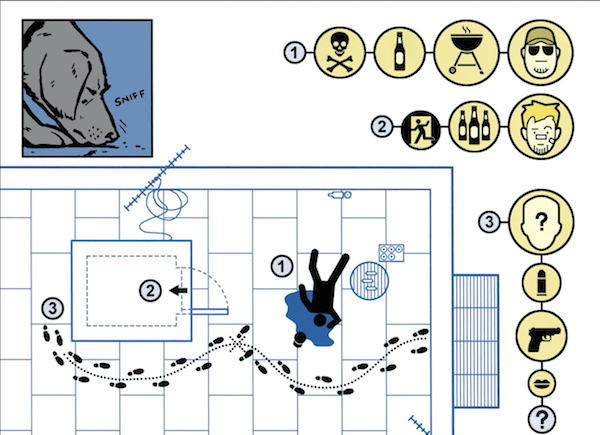
There's also a silent issue of Daredevil by Brian Michael Bendis and Alex Maleev where the blind superhero is temporarily deafened by an explosion. And there's two gorgeous mini-arcs of Daredevil by writer/artist David Mack, featuring Maya Lopez as Echo, Daredevil's deaf, super-powered love interest and counterpart.

Hawkeye's also been temporarily deaf twice before: once in the limited series Hawkeye, back in the 1980s (his use of a hearing aid made him a minor hero to hearing-impaired readers) and (it's revealed in this new issue) also as a child, as a result of an injury implied to be caused by his abusive father. This is how Clint and his brother Barney are shown to know American Sign Language.
I've been interested in ASL for a long time for personal reasons, but also as a kind of "writing," in the family-resemblance sense of visible language, that functions like speech.
Comic books, at least in print, are a silent medium by necessity. But it's still harder to render ASL in comics than ordinary oral/aural speech, because it's a language of movement, and we don't have the conventions of speech bubbles and the alphabet.
What we do have is a graphic tradition of maps, signs, atlases, manuals, and other forms of everyday iconography to draw on. And those are largely what Mack used in Daredevil, and what Aja uses in Hawkeye.
It's a sign that we, all of us, read signs everywhere, and every kind of reading can be used and incorporated in every other kind. The best way to stay true to what's essential in a medium is to do your best to explode your way out of it.
Every cup of coffee is a spectacle of logistics
Hi, everybody! Tim Carmody here, guest-hosting for Jason this week.
Robinson Meyer drank a cup of coffee shipped hot overnight from a roaster in Minneapolis to The Atlantic's office in DC as part of a Thermos promotion. He traces the beans, cultivated in Kenya and grown in El Salvador, all the way to his mug:
[T]here's something that enables all of this, from my supping of the coffee to your reading this now: the global supply chain. The ability to fling ingredients and products from coast-to-coast and continent-to-continent makes not only Thermos's contest but Spyhouse's very business possible. It's the supply chain that moves coffee beans from El Salvador to Minneapolis, where they can be roasted and sipped in days. It's the supply chain—in the form of FedEx, which, remember, has the world's fourth largest collection of aircraft—that performs the final stunt of getting coffee around the lower 48 in half a day.
Behind every ingredients list stand the movers and shippers of our world: each, like FedEx, possessing a private army of execution. I accepted Thermos's coffee contest because it seemed a spectacle of logistics. But every single day of our lives is already that.
Meyer's essay is part of what seems like a still-developing genre—Paul Ford's essay on "the American room" is another example—of stories that excavate the hidden infrastructure that make everyday experiences possible. These systems are utterly prosaic exactly because they're the product of huge amounts of manpower and material working according to painstakingly developed protocols. The author's motivation for exposing them seems to be to both demystify and reenchant the world, and the attitude expressed is a mixture of admiration, awe, and dread.
Neal Stephenson's classic Wired essay "Mother Earth, Mother Board" might be the model for the genre, like Tolkien is for epic fantasy. Let's call it the "systemic sublime."
Möbius Bagel
What if you wanted to cut a bagel in half not for toasting or sandwich purposes, but to explore its topology and mildly astonish your friends?
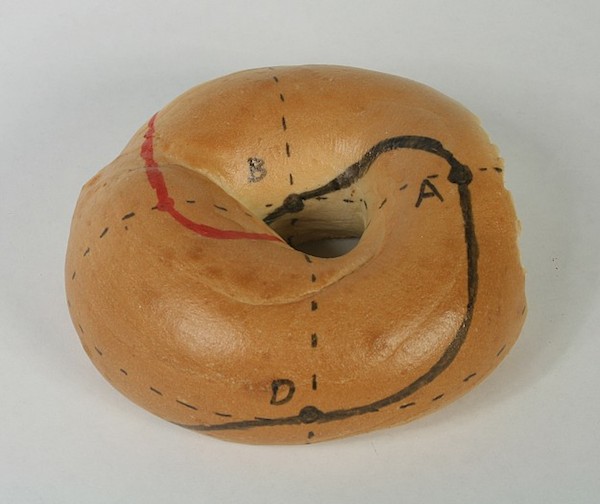
If you cut a bagel along a möbius strip pattern, you end up with two separate halves that form interlocking rings, as shown below.

Geoge Hart, who cut this bagel and made this video, is an engineering professor at SUNY-Stony Brook and "mathematical sculptor. On his web site, he offers two bagel-derived math problems: What is the ratio of the surface area of this linked cut to the surface area of the usual planar bagel slice? and Modify the cut so the cutting surface is a one-twist Mobius strip.
Via @mark_e_evans and The Onion A/V Club.
The last of the great Twitter apps
Hi, everybody! Tim Carmody here, guest-hosting for Jason this week.
There are fewer third-party Twitter applications in active development than there used to be, since Twitter built its own clients, clamped down on apps that "replicate Twitter's core user experience," limited the number of new user tokens third parties could get, and otherwise kinda spiked the well.
But there are still some gems out there, including some I was surprised I'd never heard of. Joanna Geary, Twitter's head of news in the UK, recently put together a shortlist of 30 third-party webapps useful for journalists. Here are three I've been using and enjoying:
- Followerwonk includes a number of useful searching and sorting tools, some free, some paid. I was especially impressed that it can give an inferred gender breakdown of your follows and followers that includes "undetermined" as a category. (A lot of other tools break everything down into male and female, which isn't a good binary for human bodies, let alone the zoography of Twitter.) Being able to search Twitter bios is useful too.
- TweetBe.at is a list manager. Twitter's been neglecting lists — on the website "Lists" is even hidden behind an otherwise superfluous "More" button, inside your own profile — but they're really useful. It's just that even in the best third-party apps, it's not easy to add or edit them. This fills that gap.
- My favorite Twitter tool right now is BioIsChanged, which (you might guess) tracks bio and avatar changes for the folks you follow on Twitter. You can see when someone changed jobs, took a new headshot, or otherwise tweaked what they're about online. What I like best is its customization: you can get new bio notifications in real-time (too much for me!), in daily or weekly digest emails (perfect!), or just whenever you check into the website. I'm getting better at pretending to be superhumanly attentive already.
Two other Twitter tools worth trying that aren't part of Geary's list but are worth a look:
I just started with Nuzzel, but it comes highly recommended by Christopher Mims and Lauren Goode, two reporters whose judgment I trust. Like Flipboard and Newsle and a handful of others, it pulls web links from your Twitter and Facebook feeds, sorting them by the most-shared. A good way to see what everybody's talking about at a glance.
And Happy Friends is a mailbox/outline reader for Twitter that's hard to explain but fun to use once you get into it. It's not like anything else out there, which might be the best compliment I can give it.
Update: I missed an app that I've been using for so long and so often that I forgot to mention it. ThinkUp, which offers "analytics for humans." The best thing about ThinkUp are its email "insights" digests, which tell me things like which users I'm talking to most often, whether I'm retweeting too many of my own replies (hint: when I asked you what you name your computers yesterday, I retweeted probably a few too many of your answers), and other little mini-analyses.
I also have to put in a plug for YoruFukurou, my favorite client for Mac. (I hope your tokens don't run out, YF.) It's a customizable, high-powered app that handles lists and spam reporting and link and image expansion well, but it doesn't have that oh-my-god, Ozymandias-watching-30-TV-screens-at-once thing that TweetDeck has. An elegant weapon for a more civilized age.
The first world atlas confused Cuba with Cyprus
The Utrecht University Library tells the story of a 1606 edition of Gerard Mercator's Atlas sive Cosmographicae Meditationes... that was, um, less than perfectly prepared:
In the Utrecht copy shown here the map of Cyprus has been included twice. One time at the right place at the description of the island, and one time incorrectly at the description of Cuba! To err is human, also when making an atlas. In this case the printer used the wrong copperplate when printing the map on the overleaf of the text pages which had been made earlier via another technique, namely letterpress printing. Or a mistake must have been made during the collection of the map prints needed, if the texts had to be printed afterwards. The latter way of working was quite unusual however. As far as we know, only the Utrecht copy contains the mistake of the switched Cuba-Cyprus map. But that is not to say that incorrect placements and switched maps did not occur in other old atlases. In a copy of the same edition of Mercator's atlas, housed in the University Library of Odense, the continent map of Africa has been switched with the one of America.

Mercator (of projection fame) had died in 1594. His Atlas the first "book work with maps (1585-1595) which was given the name Atlas," and popularized the term, but Abraham Ortelius's "Theatrum Orbis Terrarum" in 1570 was probably the first book we'd recognize as a modern atlas. Mercator wanted to bring scholarly, scientific precision to the work that Ortelius and a generation of mostly-Dutch commercial mapmakers had pioneered.
But the atlas was unfinished, with only 79 of a planned 120 published, and another 34 complete. There were no maps of continents outside Europe, or even of Spain and Portugal. Mercator's son Gerard Jr. sold his father's copperplates, and they eventually ended up in the hands of cartographer Jodocus Hondius. Hondius assembled and augmented Mercator's maps, adding four maps of Africa, eleven of Asia, and five of the Americas, plus correcting that pesky Iberian peninsula problem. He published them as a series, they became hugely popular, and Mercator's reputation was restored.
But there is that one weird Utrecht edition with Cyprus standing in for Cuba and Africa for America. Still, in fairness to whoever switched the bookplates: they had probably never seen images of any of these places before.
YouTube's invisible standards
Great essay by Paul Ford on the hidden infrastructure that makes most of your favorite user-created viral videos possible: 4' by 8' by 1/2" slabs of drywall, screwed into studs and painted beige.
The people dancing and talking and singing in beige rooms with 8' ceilings are surrounded by standards, physically and online. Technological standards like HTML5 also allow us to view web pages and look at video over the Internet. All of their frolic is bounded by a set of conventions that are essentially invisible yet define our national physical and technological architecture. Their dancing, talking bodies are the only non-standardized things in the videos.
Naming the machines
Hi, everybody! Tim Carmody here, guest-hosting for Jason this week.
Not everybody gives their computers, smartphones, or wireless networks distinctive names. You're more likely to see a thousand public networks named "Belkin" or some alphanumeric gibberish than one named after somebody's favorite character in The Hitchhiker's Guide to the Galaxy.
But many, many people do name their machines — and ever since we slid into the post-PC era, we're more likely to have a bunch of different machines of every different type living together on a network, each needing a name. So, how do you decide what to call them? Do you just pick what strikes your fancy at the moment, or do you have a system?
About three years ago, I asked my friends and followers on Twitter this question and got back some terrific responses. I don't have access to all of their answers, because, well, time makes fools of us all, especially on Twitter. But I think I have the best responses.
Most people who wrote back did have unifying themes for their machines. And sweet Jesus, are those themes nerdy.
- A lot of people name their computers, networks, and hard drives after characters, places, and objects from Star Wars. Like, a lot of them.
- Even more of my friends name devices after their favorite books and writers. My favorite of these came from @DigDoug: "All of my machines are named after characters in Don Quixote. My Macbook is Dulcinea, the workhorse is Rocinante." (Note: these systems are also popular among my friends for naming their cats. I don't know what to make of that.)
- Science- and mythology-inspired names are well-represented. Mathias Crawford's hard drives are named after types of penguins; Alan Benzie went with goddesses: "The names Kali, Isis, Eris, Juno, Lilith & Hera are distributed around whatever devices and drives I have at any time." (When I first read this, I thought these might have been moons of Jupiter, which would both split the difference between science and mythology and would be a super-cool way to name your stuff.)
- Wi-fi networks might be named for places, funny phrases, or abstract entities, but when it comes to phones or laptops, most people seemed to pick persons' names. Oliver Hulland's hard drives were all named after muppets; Alex Hern named his computer's hard drive and its time capsule backup Marx and Engels, respectively.
- Some people always stuck with the same system, and sometimes even the same set of names. A new laptop would get the same name as the old laptop, and so forth — like naming a newborn baby after a dead relative. Other people would retire names with the devices that bore them. They still refer to them by their first names, often with nostalgia and longing.
As for me, I've switched up name systems over the years, mostly as the kinds of devices on my network have changed. I used to just have a desktop PC (unnamed), so I started out by naming external hard drives after writers I liked: Zora, after Zora Neale Hurston, and then Dante. The first router I named, which I still have, is Ezra.
Years later, I named my laptop "Wallace": this is partly for David Foster Wallace, but also so I could yell "where the fuck is Wallace?!?" whenever I couldn't find it.
Without me even realizing it, that double meaning changed everything. My smartphone became "Poot." When I got a tablet, it was "Bodie." My Apple TV was "Wee-Bay," my portable external drive "Stringer." I even named my wi-fi network "D'Angelo" — so now D'Angelo runs on Ezra, which connects to Dante, if that makes sense.
As soon as it was Wallace and Poot, the rules were established: not just characters from The Wire, but members of the Barksdale crew from the first season of The Wire. No "Bunk," no "Omar," no "Cheese." And when the machines died, their names died with them.
The first one to go, fittingly, was Wallace. I called the new machine "Cutty." I was only able to justify to myself by saying that because he was a replacement machine, it was okay to kick over to Season 3. Likewise, my Fitbit became "Slim Charles."
Now, for some reason, this naming scheme doesn't apply at all to my Kindles. My first one was "Tlon, Uqbar, Orbis Tertius," and its replacement is "Funes the Memorious." I have no explanation for this, other than to say that while all my other devices commingle, the Kindles seem to live in a hermetic world of their own.
Paul's Boutique Minus Paul's Boutique
Hi, everybody! Tim Carmody here, guest-hosting for Jason this week.
July 25 was probably the 25th anniversary of Beastie Boys' Paul's Boutique. (Google and a few other sources say the release date was actually June 25, but July 25 is the consensus.) There's a new mural of the group, painted by Danielle Mastrion, at the corner of Ludlow and Rivington, on New York's Lower East Side, where the album cover was shot.
This remix of Paul's Boutique, released a few years ago, has also been recirculating on Twitter and Soundcloud. Caught in the Middle of a Three-Way Mix, by DJ Cheeba, DJ Moneyshot, and DJ Food, recombines the album's original source tracks and a capella verses with audio commentaries and a handful of newer songs.
The remix is fun to listen to, but mostly, it just reminds you that Paul's Boutique sounds amazing because its sampled sources were amazing. Like De La Soul's Three Feet High and Rising, released the same year, Paul's Boutique lifts tracks that would cost a small mint to borrow from today. (Three Feet High has never had an official digital release because the rights holders still can't sort out the royalties.) The Beatles, The Supremes, The Ramones, Curtis Mayfield, Dylan, Hendrix, Sly, Bernard Hermann, and James Brown (of course) are all there. But mostly, it's a love letter to old-school New York City hip hop: Kurtis Blow, Afrika Bambaataa and the Jazzy 5, The Sugarhill Gang, The Funky 4 +1, and contemporaries like Run-DMC, Boogie Down Productions, and Public Enemy are the glue that holds the whole project together.
Now, if you know Paul's Boutique well, you can't hear those older songs any more without hearing Paul's Boutique. There's specific moments in those songs that hide there waiting for you to trip over them, like quotations of ancient Greek in an Ezra Pound or TS Eliot poem. Beastie Boys didn't just find a way to make older music sound new; they found a way to invent their own precursors.
It's still wonderful to go back to the roots. In 2012, I found tracks from a handful of playlists and website listings and edited them together to make a Spotify playlist that I called "Paul's Boutique Without Paul's Boutique." (Later, I updated it using Benjamin Wintle's comprehensive playlist, which is really the base here — he did an amazing job tracking down these songs.) It's just the sampled songs, roughly in the order they appear on the album. It's ridiculously fun. I like it better than the three-DJ mix, and I might like it even better than the Beasties' album.
It feels like you're at an amazing party at Adam Yauch's house, the Dust Brothers have control of the record player, and Mike D and Adam Horowitz are watching TV and telling you jokes the whole time. I never want it to end.
Update: Scott Orchard made a version of this playlist on Rdio, for the Rdio fans in the house.
The mystery of the Wu-Tang name generator
Hi, everybody! Tim Carmody here, guest-hosting for Jason this week.
You probably know that Donald Glover (actor on Community, writer on 30 Rock) also has a rap career under the stage name Childish Gambino. You may not know that the name "Childish Gambino" comes from a Wu-Tang Name Generator.
That's half of the reason I'm here - I'm dead serious. Like I met RZA and he was like, "you're a cool dude, man - and your name is perfect for you! It's like that computer had a brain!" But yeah, I put my name in a Wu-Tang name generator and it spit out Childish Gambino, and for some reason I just thought that fit.
Now here's where things get a little weird. There are multiple, competing Wu-Tang name generators. (Of course there are.) Most of them seem to work the same way — they run a script matching your name's characters with a decent-sized database of Wu-sounding words, kind of like a hash. But little differences in the scripts or in the database give you different results.
For instance, at recordstore.com, the "Original Wu Name Generator" (tagline "WE CAN WU YOU!") spits back "Erratic Assassin" (for "Timothy Carmody"), while "Tim Carmody" yields "Well-Liked Assman." These names are both awesome.
But the "Wu-Tang Name Generator" at mess.be ("Become a real Wu warrior, entah ur full name 'n smack da ol' dirty button"), which proprietor Pieter Dom says was made in 2002, is totally different. There, "Timothy Carmody" and "Tim Carmody" return "Shriekin' Wizard" and "Gentlemen Overlord," respectively. Now, while these definitely sound like Wu names, they are definitely The W to the other site's Enter the 36 Chambers.
Here's the weird part: both of these Wu-Tang name generators return the same name for "Donald Glover." It is, of course, "Childish Gambino."
Is it just a quirk that whatever difference crept in affects most names, but not Donald Glover's? Did one of the sites hard-code that result in, to boost its credibility with people who heard the Childish Gambino story? Or is Donald Glover somehow necessarily Childish Gambino, across all possible Wu-accessible worlds, in the same way that "Clifford Smith" is always and only "Method Man," even when he pretends to be an actor?
I don't think we can ever know. But just as Russell Jones was Ol' Dirty Bastard, ODB, Dirt McGirt, Big Baby Jesus, and Ason Unique as well as Osirus, I am content to be known by many names under the Wu.
(Dedicated to "Sarkastik Beggar" and "Lesbian Pimp." Via @hoverbird.)
Update: The TLDR podcast did a follow-up to this story: The Mystery of Childish Gambino.
The history of information
This timeline of the history of information has some outstanding rabbit-holes: multiple entries on the history of magnetic card readers, Plimpton 322 (a cuneiform tablet called "the most famous original document of Babylonian mathematics"), and a whole series on crimes, forgeries, and hoaxes. The most developed entries and companion essays are on books and the book trade (the proprietor is an antiquarian bookseller), and the whole thing has got a noticeably Western Civ slant, but there's something here for everyone.
This American Lear
This American Life host and radio superpersonality Ira Glass went to see a play and came away more vexed than Claudius walking out of The Mousetrap in Elsinore.
@JohnLithgow as Lear tonight: amazing. Shakespeare: not good. No stakes, not relatable. I think I'm realizing: Shakespeare sucks.
— Ira Glass (@iraglass) July 28, 2014
But it's not a one-off thing! Glass says he's been building to this conclusion for a long time, straining like Caliban under Prospero's yoke:
Same thing with the great Mark Rylance shows this yr: fantastic acting, surprisingly funny, but Shakespeare is not relatable, unemotional.
— Ira Glass (@iraglass) July 28, 2014
So what's going to happen? Will bespectacled literary nerds have to choose between Chicago's adopted son Ira and our old friend Stratford Billy? That's like Prince Hal having to choose between getting drunk with Falstaff and cleaning up his act for his dad the king!
Be not afraid, gentles — reporter Lois Beckett is on it, with a retelling of King Lear specially updated for Ira Glass's post-Renaissance storytelling sensibilities. It's This American Lear.
Update: Jesse Lansner did a second, extended Storify collection of "This American Lear," including some of the other reactions to Glass's and then Beckett's tweets. On Twitter, Beckett called this "the director's cut."
Why don't OKCupid's experiments bother us like Facebook's did?
Hi, everybody! Tim Carmody here, guest-hosting for Jason this week.
OK Cupid's Christian Rudder has responded to the outcry over Facebook's experiments with user emotions by... publishing a list of experiments that the dating site has run on its users, along with their results.
And it's not little stuff either! To test its matching algorithms, OKC has selectively hidden users' profile images, their profile text, and even told pairs of users they were a good match when the algo said they weren't, and vice versa.
In short, Facebook may have hid stuff from you, but OK Cupid might have actually lied to you.
But... nobody's really upset about this. Or if they are, they're mostly just upset (or dryly observing, it's hard to tell) that other people aren't upset.
Why? I have some theories:
- It's early yet. It took the Facebook story some time to steep before it really picked up steam.
- OKC users are less likely to be troubled by this sort of thing than Facebook users are. And people get more upset when they feel like they personally might have been messed with. Hilary Parker pointed out that non-online daters are less likely to get upset on online daters' behalf: even if you don't actively look down on OKC users (and many do), you might be more likely to think they got what they deserved. OK Cupid has a history of disclosing these kinds of numbers, and there's a laissez-faire attitude towards users gaming accounts for their own purposes.
- We trust Facebook in a way we don't trust OKC. Facebook is the safe baby internet, with our real friends and family sending us real messages. OKC is more internet than the internet, with creeps and jerks and catfishers with phony avatars. So Facebook messing with us feels like a bigger betrayal.
- OKC's matching algorithm may be at least as opaque as Facebook's news feed, but it's clearer to users that site matches and views are generated using an algorithm. Reportedly, 62 percent of Facebook users weren't aware that Facebook's news feed was filtered by an algorithm at all. (That study has a small sample size, but still, we can infer that lots of Facebook users have no idea.)
- The results of OKC's experiments are less troubling. Facebook's study showed that our posting behavior (and maybe our feelings) were pretty susceptible to manipulation without a whole lot of effort. OKC's results seemed more complimentary. Sure, lots of people on dating sites are shallow, and sometimes you may have ended up in longer conversations than you might like with incompatible people, but good matches seem to find a way to connect no matter what OKC tells us! So... the algorithm works and I guess we can trust what they tell us? My head hurts. (Jess Zimmerman adds that part of the Facebook intervention was deliberately designed to cause harm, by making people unhappy, at least as mediated through their posts. The difference here depends on whether you think trying to match you up with someone incompatible might be causing them harm.
- The tone of the OKC post is just so darned charming. Rudder is casual, self-deprecating. It's a blog post! Meanwhile, Facebook's "emotional contagion" scholarly paper was chillingly matter-of-fact. In short, the scientism of the thing just creeped us the fuck out.
- This is related to the tone issue, but OKC seems to be fairly straightforward about why it performed the experiment: they didn't understand whether or how their matching algorithm was working, and they were trying to figure that out to make it better. Facebook seemed to be testing user's emotional expressions partly to solve a scholarly dispute and partly just to see if they could. And most of the practical justifications folks came up with for the Facebook study were pretty sinister: tricky folks into posting more often, into clicking on ads, into buying stuff. (Really, both experiments are probably a mix of product testing and shooting frogs for kicks, but the perception seems to be different.)
- The Facebook study had an added wrinkle in that academics were involved in designing the study and writing it up. This raised all sorts of factual and ethical issues about university institutional review boards and the responsibility of the journal's editors and publishers that don't seem to be relevant here. I mean, maybe SOMEbody should be veryifying that experiments done on human subjects are ethical, whether it's in a university, medical, or government context or not, but it's not like someone may have been asleep at the switch. Here, there is no switch.
- Maybe we're all just worn out. Between Facebook, this, Uber ratings, and god knows what, even if you're bothered by this kind of experimentation, it's more difficult to stay angry at any one company. So some people are jaded, some people would rather call attention to broader issues and themes of power, and some people are just tired. There's only so many times you can say "see? THIS! THIS is what I've been telling you about!" or "I can't believe you're surprised by this" before you're just like, ¯\_(?)_/¯.
I don't agree with all of these explanations, and all of them feel a little thin. But maybe for most of us, those little scraps of difference are enough.
Update: Here's a tenth reason that I thought of and then forgot until people brought up variations of it on Twitter: Facebook feels "mandatory" in a way that OKCupid doesn't. It's a bigger company with a bigger reach that plays a bigger part in more people's lives. As Sam Biddle wrote on Twitter, "Facebook is almost a utility at this point. It's like ConEd fucking with us."
The secret rites of Minecraft
"Minecraft is a game about creation," writes Robin Sloan. "But it is just as much a game about secret knowledge."
There's no official manual, so the game's teeming network of devotees, young and old, proper publishers and web-based wildcats, have worked to create them by the score. Not just guides, but wikis, videos, hints, tricks. The rules can only be discovered by observation, reasoning, and experiment. Like science — or magic:
Imagine yourself a child. Imagine yourself given one of these books: not merely a story of exploration and adventure, but a manual to such.
Imagine yourself acquiring the keys to a mutable world in which you can explore caves, fight spiders, build castles, ride pigs, blow up mountains, construct aqueducts to carry water to your summer palace... anything.
Imagine yourself a child, in possession of the secret knowledge.
Maybe the most interesting thing about this, Robin writes, is how the game "calls forth" the books — another kind of magic. Is this a function of how much Minecraft players love the game? Or is that arcane, indirect, networked, bottomless well of knowledge, asking to be impossibly filled, what they love about it?
The future of birthdays
Joanne McNeil charts where the internet of things is headed:
You wake up to a jazzy MIDI version of the "Happy Birthday" song. Your smart thermostat and smoke detector are singing in harmony because today is your day. Your fitness tracker is vibrating in an unfamiliar Morse Code. Searching the internet, you come across a question in the support forums about it, explaining it is the preprogrammed birthday greeting silent alarm that you can disable after pairing the device again and updating your settings. Your bathroom scale, toilet, and garage door also welcome you with birthday wishes. Open up the refrigerator to another friendly jingle. Tropicana, Fage, and Sabra Hummus all wish you happy birthday. Now there's an incoming message. It is the "birthday selfie" it snapped when you reached for the orange juice.
Sometimes, our identity-obsessed web services are creepy because they know so much about us, and sometimes they're creepy because they're just so damned shallow.
The new Haruki Murakami novel
Hi, everybody! Tim Carmody here, guest-hosting for Jason this week.
Slate has an excerpt of Haruki Murakami's new novel Colorless Tsukuru Tazaki and His Years of Pilgrimage. It's more or less self-contained, a story within a story. But of course, even within the excerpt, those nesting frames start collapsing:
Haida stopped and glanced at the clock on the wall. Then he looked at Tsukuru. He was, of course, Haida the son, but Haida the father had been his same age in this story, and so the two of them began to overlap in Tsukuru's mind. It was an odd sensation, as if the two distinct temporalities had blended into one. Maybe it wasn't the father who had experienced this, but the son. Maybe Haida was just relating it as if his father had experienced it, when in reality he was the one who had. Tsukuru couldn't shake this illusion.
"I just silently accept everything as it is," says another character, Midorikawa. "That's my basic problem, really. I can't erect a decent barrier between subject and object."
There's also magic, death, and jazz, plus a fair bit of discussion about the value of life and imagination. Just a treat.
Old Town Music Hall
From This Must Be the Place, a lovely short profile of Old Town Music Hall in El Segundo, California. Old Town shows silent films with live musical accompaniment. Includes a brief tour of the inner workings of the theater's wind-powered pipe organ from 1925.
Clickbaiting the 10 Commandments
Over at McSweeney's, David Tate imagines more engaging copy for the Ten Commandments, aka you won't believe what God said to this man...
At the Beginning He Had Me Confused, But by Minute Two I Knew That I Shouldn't Have Other Gods.
37 Things in Your Bedroom That You Need to Get Rid of Right Now, Like Adulteresses.
Werner the Herzog

Magisterial. (via @moleitau)
Explaining Hitler
Explaining Hitler is a 1998 book by Ron Rosenbaum that compiled a number of different theories about why Adolf Hitler was the way he was, updated recently with new information.
Hitler did not escape the bunker in Berlin but, seven decades later, he has managed to escape explanation in ways both frightening and profound. Explaining Hitler is an extraordinary quest, an expedition into the war zone of Hitler theories. This is a passionate, enthralling book that illuminates what Hitler explainers tell us about Hitler, about the explainers, and about ourselves.
Vice recently interviewed Rosenbaum about the book.
Oh my God, there are so many terrible psychological attempts to explain Hitler. I think the subject brings out the worst in talk show psychologists. There's a lot of 'psychopathic narcissism' among those psychologizing Hitler. The examples in my book were two psychoanalysts-one wanted to claim that Hitler became Hitler because he was beaten by his father, and the other psychoanalyst was equally determined to believe that Hitler had a malignant mother who was over-protective. As if everyone who has an over-protective mother or abusive father turns into Hitler. If everyone who has been struck by their father turned into Hitler we would be in a lot more trouble than we are.
Related by not related: Rosenbaum wrote a story in 1971 for Esquire about phone phreaking, Secrets of the Little Blue Box, which inspired the very first partnership between a pair of young future tech titans, Steve Wozniak and Steve Jobs. (via @errolmorris)
Update: Rosenbaum talks about Explaining Hitler on the Virtual Memories podcast.
A short history of the high five
For the latest installment of Grantland's 30 for 30 short documentary series, a story on the genesis of the high five and what happened to one of its inventors. This video is chock full of amazing vintage footage of awkward high fives. [Weird aside: The sound on this video is only coming out of the left channel. Is that a subtle homage to the one-handed gesture or a sound mixing boner?]
Do you have a reservation?
Alexis Madrigal wonders: when did the idea of the dinner reservation come about?
Reserving a table is not so much an "industrial age bolt-on" as it's a slippage from the older custom of reserving a ROOM in a restaurant. As my book explains, 18th-cy "caterers" [traiteurs] either served clients in their homes or in rooms at the traiteur's, the first self-styled restaurateurs borrowed from cafes in having lots of small tables in one big room. Throughout the nineteenth century, many big city restaurants continued to have both a (very) large public eating room with numerous, small (private) tables AND a number of smaller rooms that could be reserved for more private meals. (Much as some restaurants have special "banquet facilities" or "special occasion" rooms today.)
For sale. Knockoff Jeff Koons. $500.
A seller on Chinese b2b site Alibaba is offering stainless steel sculptures of balloon animal dogs in the style of Jeff Koons. For as little as $500, you can get your own knock-off copy of Balloon Dog, which sold for $58 million last year.

Koons' dog was about 10 feet tall but the seller notes they can make them anywhere from 3 feet tall to almost 100 feet tall. Jiminy. I wonder what these things look like? I bet they aren't nearly as precise as the originals, but you never know. See also: Rex Sorgatz's Uber for Art Forgeries. (via prosthetic knowledge)
The Collapse of Western Civilization: A View from the Future
From a pair of science historians, Naomi Oreskes and Erik Conway, comes The Collapse of Western Civilization: A View from the Future, a book of science fiction about the consequences of climate change.
The year is 2393, and a senior scholar of the Second People's Republic of China presents a gripping and deeply disturbing account of how the children of the Enlightenment, the political and economic elites of the so-called advanced industrial societies, entered into a Penumbral period in the early decades of the twenty-first century, a time when sound science and rational discourse about global change were prohibited and clear warnings of climate catastrophe were ignored. What ensues when soaring temperatures, rising sea levels, drought, and mass migrations disrupt the global governmental and economic regimes? The Great Collapse of 2093.
Update: In the same vein is Steven Amsterdam's Things We Didn't See Coming.
Richly imagined, dark, and darkly comic, the stories follow the narrator over three decades as he tries to survive in a world that is becoming increasingly savage as cataclysmic events unfold one after another. In the first story, "What We Know Now" — set in the eve of the millennium, when the world as we know it is still recognizable — we meet the then-nine-year-old narrator fleeing the city with his parents, just ahead of a Y2K breakdown. The remaining stories capture the strange — sometimes heartbreaking, sometimes funny — circumstances he encounters in the no-longer-simple act of survival; trying to protect squatters against floods in a place where the rain never stops, being harassed (and possibly infected) by a man sick with a virulent flu, enduring a job interview with an unstable assessor who has access to all his thoughts, taking the gravely ill on adventure tours.
(thx, matty)
A menagerie of birds from the future
The Silva Field Guide to Birds of a Parallel Future, featuring several videos of how futuristic birds might move. For instance, here's a deconstructed bird in the shape of a Borg cube:
Botanical space flight
Bonsai! In! Spaaaaaaaace!!

This image is from Exobiotanica, a project that sent various plants about 100,000 feet into the sky.
Don't Fly Drones Here

From Mapbox, a map of places in the US where it is unsafe or illegal to fly drones. Forbidden areas include near airports and in National Parks. (via @tcarmody)
LeBron James Has a Photographic Memory
The evidence has mounted to such an extent that Brian Windhorst of ESPN has written an article about LeBron James' fantastic memory.
So what does it mean? What it seems to suggest — at least the part of it that James will discuss — is that if you give up the baseline to James on a drive in November 2011 and he's playing against you in March 2013, the Heat small forward will remember it. It means that if you tried to change your pick-and-roll coverage in the middle of the fourth quarter of the 2008 playoffs, he'll be ready for you to try it again in 2014, even if you're coaching a different team. It also means that if you had a good game the last time you played against Milwaukee because James got you a few good looks in the first quarter, the next time you play the Bucks you can count on James looking for you early in the game. Because, you know, the memory never forgets.
"I can usually remember plays in situations a couple of years back — quite a few years back sometimes," James says. "I'm able to calibrate them throughout a game to the situation I'm in, to know who has it going on our team, what position to put him in.
"I'm lucky to have a photographic memory," he will add, "and to have learned how to work with it."
Which sounds great, right? Except that thinking's best friend is often overthinking.
Consider what you know of the 2011 NBA Finals. And now consider it, instead, like this: In what will likely be remembered as the low point of his career, James is miserable for several games against the Dallas Mavericks — including a vitally important Game 4 collapse when he somehow scores just eight points in 46 minutes. At times during that game it appears as if James is in a trance.
"What is he thinking?" the basketball world wonders.
James — with two titles and counting, and four straight trips to the Finals — can admit today what he's thinking in 2011: He's thinking of everything. Everything good, and everything bad. In 2011, he isn't just playing against the Mavs; he's also battling the demons of a year earlier, when he failed in a series against the Boston Celtics as the pressure of the moment beat him down. It's Game 5 of the 2010 Eastern Conference semifinals, and it is, to this point, perhaps the most incomprehensible game of James' career. His performance is so lockjawed, so devoid of rhythm, the world crafts its own narrative, buying into unfounded and ridiculous rumors because they seem more plausible than his performance.
I've probably said this a million times, but my favorite aspect of sports is the mental game, each athlete's battle with her/himself: from Shaq's dreamful attraction to Allen Iverson's visualization in lieu of practice to better living through self deception to Roger Federer's conservation of concentration to free diver Natalia Molchanova's attention deconcentration to deliberate practice to relaxed concentration. James taming his tide of memories fits right in.
The National Wildlife Property Repository
The crew at The Atlantic Video takes a trip to The National Wildlife Property Repository, which stores confiscated illegal wildlife items.
The National Wildlife Property Repository, a government facility outside of Denver, stores more than a million products of the illegal wildlife trade, from tigers and bears to elephant ivory. These items are confiscated at points of entry around the United States, and sent to the Repository to be destroyed or used for educational purposes.
The bit about the National Eagle Repository is especially interesting. Under federal law, every dead eagle (and eagle parts, including feathers) must be sent to the repository, where they are made available for distribution to native tribes.
The primary objective of The National Eagle Repository (Repository) is to receive, evaluate, store and distribute bald and golden eagle carcasses, parts, and feathers to tribally enrolled Native Americans of Federally recognized tribes throughout the United States for religious purposes. The Repository serves as the collection and distribution point for bald and golden eagle salvages each year by State and Federal wildlife officials.
Goodnight Moon
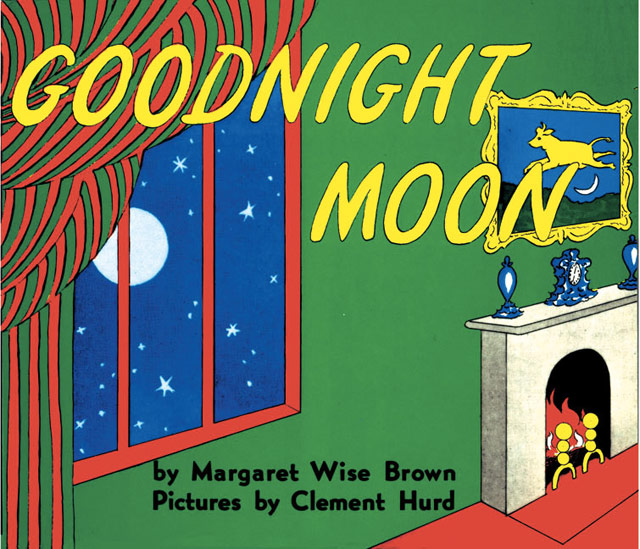
From Aimee Bender, an appreciation of Margaret Wise Brown's Goodnight Moon, a favorite of mine to read to my kids when they were younger.
"Goodnight Moon" does two things right away: It sets up a world and then it subverts its own rules even as it follows them. It works like a sonata of sorts, but, like a good version of the form, it does not follow a wholly predictable structure. Many children's books do, particularly for this age, as kids love repetition and the books supply it. They often end as we expect, with a circling back to the start, and a fun twist. This is satisfying but it can be forgettable. Kids - people - also love depth and surprise, and "Goodnight Moon" offers both.
Haven't read Goodnight Moon in ages...at 4 and 7, my kids protest whenever I suggest it. We're currently powering our way through the third Harry Potter book, which, though I enjoy Potter, is no Goodnight Moon.
Update: How Goodnight Moon overcame bad initial reviews and became a word-of-mouth bestseller.
The molecular structure of cities
MIT's Franz-Josef Ulm has taken to analyzing the structure of cities as if they were molecular materials like glass or crystal.
With colleagues, Ulm began analyzing cities the way you'd analyze a material, looking at factors such as the arrangement of buildings, each building's center of mass, and how they're ordered around each other. They concluded that cities could be grouped into categories: Boston's structure, for example, looks a lot like an "amorphous liquid." Seattle is another liquid, and so is Los Angeles. Chicago, which was designed on a grid, looks like glass, he says; New York resembles a highly ordered crystal.
I love this. It's like Jane Jacobs + the materials science research I did in college.
So far, Ulm says, the work has two potential applications. First, it could help predict and mitigate urban heat island effects, the fact that cities tend to be several degrees warmer than their surrounding areas-a phenomenon that has a major impact on energy use. (His research on how this relates to structure is currently undergoing peer review.) Second, he says that cities' molecular order (or disorder) may also affect their vulnerability to the kinds of catastrophic weather events that are becoming more frequent thanks to climate change.
(via 5 intriguing things)
How to survive air travel
Great piece from Craig Mod about how to survive air travel.
Authorities recommend arriving two hours before international flights. I say four. Get there four hours before your flight. You are a hundred and fifty years old. Your friends laugh at you. Have patience.
Arrive early and move through the airport like the Dalai Lama. You are in no rush. All obstacles are taken in stride, patiently, with a smile. Approach the nearly empty check-in counter. Walk up and say, I'm a bit early but I'm here to check in to ... Marvel at their surprise and then their generosity. Suddenly you are always able to get an exit row or bulkhead seat. Suddenly, sure, they can slip you into Business. Suddenly tickets that are supposedly unchangeable, cannot be modified, are, after a few calls, some frowns, upbeat goodbyes, specially modifiable for you. This is what happens when there is no one behind you in line to check in.
What Mod fails to mention here in regard to supposedly unchangeable tickets and the like is that he's one of the most disarmingly charming motherfuckers in the entire world. And here is the crux of the whole piece:
You are hacking the airport by arriving early, knowing that all the work you could have done at home — the emails or writing or photo editing — can be done at the airport.
I don't travel much anymore, but I've begun to arrive at the airport earlier than I need to because I got tired of rushing and I can work from pretty much anywhere with wifi. That mask shit though? That's too much.
Books on book covers
An extensive collection of book covers featuring books. Confused? Maybe an example will help:

Stranded on a whale
A couple in a kayak gets too close to a whale and then the whale raises them right out of the water. And not just for a moment either.
Walking City
Walking City is a slowly evolving walking video sculpture by Universal Everything. A walking tour of modern architecture, if you will.
File this one under mesmerizing. A deserving winner of the Golden Nica award at Ars Electronica. (via subtraction)
Book posters
I love these book posters by Gunter Rambow from the 1970s, especially this one:

(via @michaelbierut)
Copying is my way of learning
From Portraits in Creativity, a video profile of Maira Kalman, doer of many wonderful things.
Kalman's newest book is Girls Standing on Lawns, a collaboration with MoMA and Daniel Handler (aka Lemony Snicket).
This clever book contains 40 vintage photographs from the collection of The Museum of Modern Art, New York, more than a dozen original paintings by Kalman inspired by the photographs, and brief, lyrical texts by Handler. Poetic and thought-provoking, Girls Standing on Lawns is a meditation on memories, childhood, nostalgia, home, family, and the act of seeing.
I once saw Kalman while I was eating lunch with my son in the cafe on the second floor of MoMA. She came in and sat opposite us a few tables away and started sketching. What a thrill to watch her work. (via @curiousoctopus)
Songs that time forgot
Over at Very Small Array, an analysis of the obscurity of hit songs, i.e. which top ten songs from each year since 1900 have remained popular and which have been lost to the sands of time. Of the least popular hit songs:
Don't cry for them. All they need is one Wes Anderson movie to get back in the game.
(via waxy)
The true cost of a cheeseburger
Mark Bittman on the true cost of producing a hamburger, after accounting for externalities like carbon generation and obesity.
Cheeseburgers are the coal of the food world, with externalities in spades; in fact it's unlikely that producers of cheeseburgers bear the full cost of any aspect of making them.
This made me think of something I wrote for Worldchanging several years ago about a True Cost rating:
Wealth doesn't just magically materialize into your bank account. It comes from the ground, human effort, the flesh of animals, the sun, and the atom. The global economy is driven by nature, and yet it's not usually found on the accountant's balance sheet. Perhaps it should be. I'd like to know the true cost of the stuff I buy. Embodied energy and carbon footprint calculations are a good start, but it would be nice if the product itself came with a True Cost number or rating, like the nutritional information on a cereal box or the Energy Star rating on a refrigerator.
When True Cost is factored in, conflict diamonds become a morally expensive choice to make when they're fueling turmoil in the world. Likewise clothing made in sweatshops. Organic tomatoes flown in from Chile may be less expensive at the register, but how much carbon dioxide was released into the atmosphere flying/driving them to your table? What's the energy cost of living in the suburbs compared to living downtown? Do the people who made the clock hanging on my wall get paid a fair wage and receive healthcare? Just how bad for the environment is the laptop on which I'm typing?
(via subtraction)
The Imitation Game
The Imitation Game is a historical drama about Alan Turing, focusing on his efforts in breaking the Enigma code during WWII. Benedict Cumberbatch plays Alan Turing. Here's a trailer:
A Pickpocket's Story
Until his recent incarceration, Wilfred Rose was a very successful pickpocket operating on the streets of NYC.
Some of the thieves have a shtick. There is Francisco Hita, who when caught touching someone's wallet, pretends to be deaf, the police say, responding with gesticulations of incomprehension. There is an older man who pretends to be stricken by palsy while on a bus, and then uses a behind-the-back maneuver to infiltrate the pocket of the passenger next to him.
There are flashy dressers, like the 5-foot-3 Duval Simmons, whose reputation is so well known among the police that he says he sometimes sits on his hands while riding the subway, so he cannot be accused of stealing. Mr. Simmons, an occasional partner of Mr. Rose's, said he honed his skills on a jacket that hung in his closet, tying bells to it to measure how heavy his hand was.
Mr. Rose's notoriety stems from how infrequently he has been arrested, and how, at least in the last 15 years, he has never been caught in the act by plainclothes officers.
See also Adam Green's fascinating piece on Apollo Robbins from The New Yorker. Especially the bit about surfing attention:
But physical technique, Robbins pointed out, is merely a tool. "It's all about the choreography of people's attention," he said. "Attention is like water. It flows. It's liquid. You create channels to divert it, and you hope that it flows the right way."
Robbins uses various metaphors to describe how he works with attention, talking about "surfing attention," "carving up the attentional pie," and "framing." "I use framing the way a movie director or a cinematographer would," he said. "If I lean my face close in to someone's, like this" — he demonstrated — "it's like a closeup. All their attention is on my face, and their pockets, especially the ones on their lower body, are out of the frame. Or if I want to move their attention off their jacket pocket, I can say, 'You had a wallet in your back pocket — is it still there?' Now their focus is on their back pocket, or their brain just short-circuits for a second, and I'm free to steal from their jacket."
The Anti-Wonka Candy Factory
In 2011, Magnum photographer Martin Parr visited the Teddy Grays candy factory near Birmingham, England that makes old-fashioned candy with Wonka-esque names — Mint Humbugs, Nutty Brittles, Spearminties. The result is this ultra-charming 20 minute film profile of the company and its candy-making process.
Charmingness evidence, exhibit A: When asked if the company would ever modernize, company director Teddy Gray responds, "Imagine coming to work in the morning and looking at all them faxes, oh no." Even his modernization references need modernizing.
Charmingness evidence, exhibit B: The lingerie calendar behind Gray as he talks on the phone, and the beefcake calendar behind his daughter in the very next scene.
Charmingness evidence, exhibit C through exhibit ZZZ: Every other scene in the film.
I know 20 minutes for a web video sounds daunting, but it's worth the while. At the very least, skip to 14:00 and watch how they make "lettered rock", hard candy sticks with words written on the inside of the candy. As shown in the video, the individual letters start out 3-4 inches high, are arranged into words when rolled up into a massive tube of candy a foot in diameter, and end up a fraction of an inch tall when pulled out into small sticks, like so:

And you thought laying out type for the web was difficult. (thx, nick)
The New Yorker's new site
The New Yorker has got a new web site and with it, they are offering everything they've published since 2007 online for free all summer. From the editor's note:
Beginning this week, absolutely everything new that we publish — the work in the print magazine and the work published online only — will be unlocked. All of it, for everyone. Call it a summer-long free-for-all. Non-subscribers will get a chance to explore The New Yorker fully and freely, just as subscribers always have. Then, in the fall, we move to a second phase, implementing an easier-to-use, logical, metered paywall. Subscribers will continue to have access to everything; non-subscribers will be able to read a limited number of pieces — and then it's up to them to subscribe. You've likely seen this system elsewhere — at the Times, for instance — and we will do all we can to make it work seamlessly.
Previously, only select articles from each issue were available for free online...everything else was for subscribers only. (Umlaats and extensive commas will be forever freely available on all the New Yorker's publishing platforms.) Longform has a solid list of their 25 favorite now-unlocked pieces.
See also: In Praise of Slow Design, a piece by Michael Bierut about The New Yorker's careful design evolution.
A theory on Jon Snow's parentage
If you've been paying attention to the promos for HBO's Game of Thrones series, there's been a lot of Jon Snow sitting on the Iron Throne. When the show started, Snow seemed like a relatively minor character, but his uncertain parentage hinted at possible greater things on the horizon. Here's a video explanation of one of the more popular theories about Snow's parents:
BTW, if you, like me, haven't read the books and have only seen the TV show, the video doesn't contain any outright spoilers, only enriching context. So watch away. And if you've read the books, you probably don't need to watch the video because you're probably already aware of this old theory. If you're interested, there are more theories (and crazy spoilers) where that came from.
Little Starbucks on the Prairie
Over at McSweeney's, Gary Almeter reimagines episodes of the Little House on the Prairie TV show to reflect the presence of a Starbucks in Walnut Grove.
Charles inherits the entire estate of a wealthy uncle. Within 24 hours, the Ingallses, who are seemingly rich, suddenly become Harriet Oleson's best pals. They are pressured to make various contributions throughout the community, and they even receive newspaper article offers to chronicle this tremendous change in their lives. Things get even worse when this newfound fortune threatens the family's relationships with their real friends. Meanwhile, Nellie Oleson, to avenge a barista who broke Nellie's doll, replaces the cinnamon at the Starbucks condiments bar with cayenne pepper while Mr. Edwards finally accepts the idea that coffee can be iced.
(via @tadfriend)
Live TV coverage of Apollo 11 landing and moon walk
45 years ago today, the lunar module from the Apollo 11 mission landed on the Moon. For the 40th anniversary of the landing in 2009, I put together a page where you can watch the original CBS News coverage of Walter Cronkite reporting on the Moon landing and the first Moon walk, synced to the present-day time. I've updated the page to work again this year: just open this page in your browser and the coverage will start playing at the proper time. Here's the schedule:
Moon landing broadcast start: 4:10:30 pm EDT on July 20
Moon landing shown: 4:17:40 pm EDT
Moon landing broadcast end: 4:20:15 pm EDT
{break}
Moon walk broadcast start: 10:51:27 pm EDT
First step on Moon: 10:56:15 pm EDT
Nixon speaks to the Eagle crew: approx 11:51:30 pm EDT
Moon walk broadcast end: 12:00:30 pm EDT on July 21
Here's what I wrote when I launched the project:
If you've never seen this coverage, I urge you to watch at least the landing segment (~10 min.) and the first 10-20 minutes of the Moon walk. I hope that with the old time TV display and poor YouTube quality, you get a small sense of how someone 40 years ago might have experienced it. I've watched the whole thing a couple of times while putting this together and I'm struck by two things: 1) how it's almost more amazing that hundreds of millions of people watched the first Moon walk *live* on TV than it is that they got to the Moon in the first place, and 2) that pretty much the sole purpose of the Apollo 11 Moon walk was to photograph it and broadcast it live back to Earth.
(FYI, I didn't test it, but I'm almost positive this will *not* work on mobile...it uses YouTube's Flash player to show the video. Sorry.)
The World Cup is over. Now what?
If you enjoyed the World Cup but don't know how to proceed into the seemingly impenetrable world of soccer, with its overlapping leagues, cups, and tournaments, this guide from Grantland is for you.
Just because the World Cup is over doesn't mean soccer stops. Soccer never stops; that's one of its biggest appeals. There are so many different teams, leagues, club competitions, and international tournaments that, if you want to, you can always find someone to cheer for or some team to root against. It can also be a bit daunting to wade into without any experience. Luckily, you have me, your Russian Premier League-watching, tactics board-chalking, Opta Stats-devouring Gandalf, to help you tailor your soccer-watching habits. And now I will answer some completely made-up questions to guide you along your soccer path.
This was basically my situation after the 2010 World Cup, a soccer fan with nowhere to direct his fandom. What I did was:
1. Picked a player I enjoyed watching (Messi) and started following his club team (FC Barcelona) and, to a somewhat lesser degree, the league that team played in (La Liga). I know a lot more cities in Spain than I used to.
2. Watched as many Champions League matches as I could every year, again more or less following Barcelona.
3. Got into UEFA European Championship, which is basically the World Cup but just for Europe. It's held every four years on a two-year stagger from the WC and the next one is in 2016 in France, which, I'm realizing just now, I should try to attend.
I also watched a few Premier League matches here and there...it's a great league with good competition. What I didn't do is follow any MLS or the USMNT, although after this WC, I might give the Gold Cup and Copa America tournaments some more attention. And qualifying matches for the 2018 World Cup start in mid-2015...soccer never ends.
Behind the scenes of Orange Is the New Black
I was 29 years old and living the dream, or at least my version of it, when everything changed. I was in love with an amazing woman and had a rent-controlled sublet in New York City's West Village and a good job at a glossy magazine. By any estimation as I now recall my life before it was tossed upside down, my girlfriend and I had no discernible problems.
In Matter, Larry Smith's My Life with Piper: From Big House to Small Screen.
12 Monkeys TV series trailer
The first season of a new series based on 12 Monkeys (and La Jetée) is set to debut on Syfy in January; here's the trailer:
(via the verge)
A fake history of blogging
At The Morning News, Giles Turnbull offers up a fake history of blogging, er, bloggering.
Depending on who you ask, the first bloggering happened in the late 1990s, when the web was still young, and clicking links to pages where you'd click more links was cool. This was in the days when the only use for an animated GIF was to tell people you were still working on your web page. Even if you weren't.
"I invented bloggering," says mad old Laurence Fortey, a mad old internet guy from the old, old days. He can remember hand-coded websites. He started coding his own just weeks after Tim Berners-Lee, a tunnel engineer helping to build the STERN protein collider, discovered ancient scrolls buried in the Swiss soil that revealed the secrets of HTML.
Maps don't love you like I love you
From Flowing Data, 19 Maps That Will Blow Your Mind and Change the Way You See the World. Top All-time. You Won't Believe Your Eyes. Watch. It's the maps listicle to end all maps listicles.

Snowpiercer
This is a lie, but I got dozens of emails today asking, "Jason, what movie should I watch tonight?" Whoa, slow down everyone, I've got just the thing: Snowpiercer. It's a Korean film from 2013 that's just now trickling into the consciousness of the rest of the world (c.f. this Grantland piece). The film takes place entirely on a train carrying the last remaining humans speeding forever around a frozen Earth (caused by an overenthusiastic response to climate change) and director Bong Joon-ho takes full advantage of this confined and linear setting. Plus, Tilda Swinton as a Terry Gilliam-ified Maggie Thatcher is worth the price of admission alone.
Snowpiercer is out in ~350 theaters in the US, so if you're not in a major metropolitan area, it might be a little hard to catch. But the movie is also available digitally at Amazon and iTunes.
Elevating bread and butter
Bread and butter is often an afterthought at restaurants...the bread can be meh and bland butter served too cold to spread. Chef Dan Richer takes the bread and butter offered at his New Jersey restaurant as seriously as any of the other items on his menu.
Cultured butter is delicious...Per Se serves it as well. (via digg)
Airship hangar waterpark funtimes
In his new video, Casey Neistat and his son visit a German waterpark housed in a giant former airship hangar.
Some information on the structure from the waterpark's web site:
The Tropical Islands Dome is gigantic. In fact, it is the largest free-standing hall in the world: 360 metres long, 210 metres wide and an incredible 107 metres high.
That is big enough to fit the Statue of Liberty in standing up and the Eiffel Tower lying on its side. The Tropical Islands Dome covers an area of 66,000 m�, the size of eight football fields. And it is high enough to fit in the whole of Berlin's Potsdamer Platz, with all its skyscrapers.
(via john hodgman)
The Forest Man of India
Since 1979, Jadav Payeng has planted every single tree in a forest that covers some 1360 acres of an island in the Jorhat district of India. The forest helps prevent the erosion of the island and is now home to elephants, rhinos, tigers, and other animals. Forest Man is a short documentary film on how this forest came to be. (via @AdmiralTwombly)
A People's History of Tattooine
In the same vein as the Zinn/Chomsky Lord of the Rings commentary is A People's History of Tattooine, a Twitter conversation that Jacob Harris kicks off thusly:
What if Mos Eisley wasn't really that wretched and it was just Obi Wan being racist again?
Some other highlights:
"more civilized time?" Check your privilege, Obi Wan
the Tusken People. Raiders presumes some malevolent intent
all I'm saying is that I don't blame the Tusken People for steering clear of the racist, violent and armed old man
like anybody forgets what Luke and his friends did to native womp rat populations at Beggars Canyon Park
The Grand Budapest Hotel reviewed
There are 46 reviews (and counting) of The Grand Budapest Hotel on TripAdvisor, which is ranked "#1 of 1 hotels in The Republic of Zubrowka".
As an elderly women I was thoroughly delighted by the attention of the staff! Particularly the concierge, what a thoughtful generous man! Wish I could take him home to service me there! I also loved the food and the chocolate treats from mendls. Tip top!
See also Schrute Farms on TripAdvisor and TripAdvisor reviews for the Overlook Hotel. Oh and The Grand Budapest Hotel movie is now available for digital rental. (via @khoi)
A do-over on childhood drawings
Artist Telmo Pieper took some drawings he did when he was four years old and digitally fleshed them out.

See also making toys out of children's drawings and collaborating with a four-year-old. (via @santheo)
How ramen noodles are made
Sun Noodle makes the ramen noodles for a host of the top ramen shops in NYC, LA, and elsewhere (Ivan, Momofuku, etc.)...here's a look at how the noodles are made in their New Jersey factory:
See also how to make hand-pulled noodles and Sun Noodle's fresh ramen kits are available for retail (via devour)
Rant against birthday dinners
At The Bold Italic, an anonymous San Franciscan rails against the practice of going out to dinner with a group of friends for your birthday.
Look, I don't think I'm a cheap ass, but I typically spend under $100 on a birthday gift for my own mother. And this is San Francisco; your friends are going to range from hella rich to hella poor, and the whole premise of these group dinners makes things uncomfortable for everyone. It's not that I think birthdays need to be extravagant exercises in theme and creativity; I'm just saying there are lots of things you could do on your birthday, and a huge dinner is one of the worst. For less money and less hassle, everyone could pitch in and rent a suite at a fancy hotel with a pool. Do that. Do anything else.
(via @arainert)
Distance Over Time
In his mid-20s, James Golding was diagnosed with cancer. In the hospital, he weighed 84 pounds and was given a 5% chance of living. Five years later, he embarked on a journey to France to break the record for most distance ridden on a bike in 7 days. This video follows Golding through his record-breaking attempt.
The video was produced by the same team that did the lovely Experiments in Speed video.
The rise and fall of American smoking
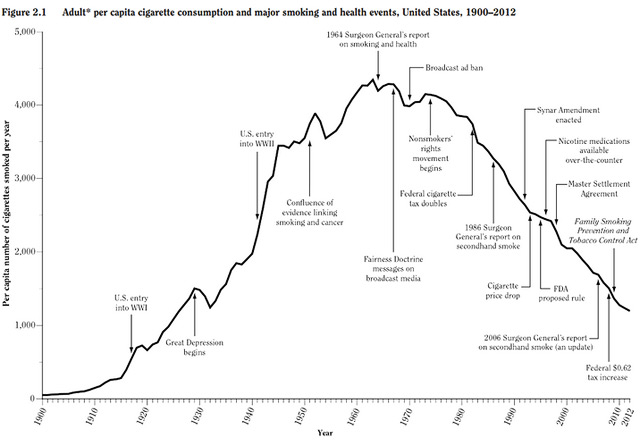
Over the past century, adult per capita cigarette consumption in the US rose from nearly nothing in 1900 to a peak of more than 4000 cigarettes per year in the early 60s and then fell to the current rate of around 1000/yr. Currently, smoking in the US correlates highly with level of education and poverty.
Smoking, as it happens, also appears to be highly correlated with both poverty and education levels in the United States: 27.9 percent of American adults living below the poverty line are smokers, while just 17 percent of those living above it are, according to the CDC; 24.7 percent of American adults without a high school diploma are smokers, while 23.1 percent of those with one are. Only 9.1 percent of those with an undergraduate degree, and 5.9 percent of those with a graduate degree are smokers.
According to Wikipedia, the US is 51st among nations in annual smoking rates. Eastern Europe and Russia hold all the top spots, but their per capita rates (~2800/yr) are all lower than the rate in the US in the 60s. But that's nothing compared to Scotland...their rate was once 7000 cigarettes per year. (via @dens)
Cyclomaniacs 2
Occasionally I'll go to my page of addictive Flash games to revisit some old favorites. I mostly play games on my phone now, but some of these are still pretty good. One of my absolute faves is a game called Cyclomaniacs, which I've played all the way through several times over the years. Last night I discovered there's a Cyclomaniacs 2. So good.
Update: There is also Cyclomaniacs Epic and a one-off called Gregmaniacs. (via @ISeeFrants)
The polar flip

According to data collected by a European satellite array, the Earth's magnetic field is shifting and weakening at a greater pace than previously thought. One of the reasons for the shift might be that the magnetic North and South poles are swapping positions.
Scientists already know that magnetic north shifts. Once every few hundred thousand years the magnetic poles flip so that a compass would point south instead of north. While changes in magnetic field strength are part of this normal flipping cycle, data from Swarm have shown the field is starting to weaken faster than in the past. Previously, researchers estimated the field was weakening about 5 percent per century, but the new data revealed the field is actually weakening at 5 percent per decade, or 10 times faster than thought. As such, rather than the full flip occurring in about 2,000 years, as was predicted, the new data suggest it could happen sooner.
You can read up on geomagnetic reversals on Wikipedia. A short sampling:
These periods [of polarity] are called chrons. The time spans of chrons are randomly distributed with most being between 0.1 and 1 million years with an average of 450,000 years. Most reversals are estimated to take between 1,000 and 10,000 years. The latest one, the Brunhes-Matuyama reversal, occurred 780,000 years ago. A brief complete reversal, known as the Laschamp event, occurred only 41,000 years ago during the last glacial period. That reversal lasted only about 440 years with the actual change of polarity lasting around 250 years. During this change the strength of the magnetic field dropped to 5% of its present strength.
Can I get some reverb on that GIF?
Audacity is a sound editing program, but it turns out you can open and edit image files with it. With varying results, mostly of the glitch art variety:

(via 5 intriguing things)
A Disappearing Planet
From ProPublica, an alarming series of graphs and charts on animal extinction: A Disappearing Planet.
Animal species are going extinct anywhere from 100 to 1,000 times the rates that would be expected under natural conditions. According to Elizabeth Kolbert's The Sixth Extinction and other recent studies, the increase results from a variety of human-caused effects including climate change, habitat destruction, and species displacement. Today's extinction rates rival those during the mass extinction event that wiped out the dinosaurs 65 million years ago.
(via @SrikarDR)
If Doctor Who were American...
Back in February, Smug Mode chose American counterparts for all of Doctor Who's past incarnations. We're talking Dick Van Dyke as the 2nd Doctor, Gene Wilder for the 4th Doctor, and Donald Glover as the 11th Doctor. Here's a nicely done faux 50th anniversary video celebrating those Doctors:
(via @moth)
A day in the life of NYC taxis
This clever and well-done visualization shows where individual NYC taxis picked up and dropped off their fares over the course of a day.

Mesmerizing. Has anyone done analysis on which drivers are the most effective and what the data shows as the most effective techniques? The best drivers must have their tricks on where to be at which times to get the most fares. (via @dens)
Infant shirts for adults
Jokey t-shirts for infants are almost never funny but putting the same shirts on adults is the best idea ever.

All the designs featured are actually available for sale — here's that I Pooped Today shirt — just click on the "See all styles" button for adult options. Ok, just one more:

(via @mulegirl)
LoTR DVD commentary from Zinn and Chomsky
This is an old piece from McSweeney's, but it's absolute gold and I can't believe I've been missing it all these years. In it, Noam Chomsky and Howard Zinn record a DVD commentary for the first Lord of the Rings movie. So, so good.
Zinn: You've spoken to me before about Mordor's lack of access to the mineral wealth that the Dwarves control.
Chomsky: If we're going to get into the socio-economic reasons why certain structures develop in certain cultures... it's mainly geographical. We have Orcs in Mordor — trapped, with no mineral resources — hemmed in by the Ash Mountains, where the "free peoples" of Middle Earth can put a city, like Osgiliath, and effectively keep the border closed.
Zinn: Don't forget the Black Gate. The Black Gate, which, as Tolkien points out, was built by Gondor. And now we jump to the Orcs chopping down the trees in Isengard.
Chomsky: A terrible thing the Orcs do here, isn't it? They destroy nature. But again, what have we seen, time and time again?
Zinn: The Orcs have no resources. They're desperate.
Chomsky: Desperate people driven to do desperate things.
Zinn: Desperate to compete with the economic powerhouses of Rohan and Gondor.
Chomsky: Who really knows their motive? Maybe this is a means to an end. And while that might not be the best philosophy in the world, it makes the race of Man in no way superior. They're going to great lengths to hold onto their power. Two cultures locked in conflict over power, with one culture clearly suffering a great deal. I think sharing power and resources would have been the wisest approach, but Rohan and Gondor have shown no interest in doing so. Sometimes, revolution must be —
Zinn: Mistakes are often —
Chomsky: Blood must be shed. I forget what Thomas Jefferson —
Here's part two. And the same writers, Jeff Alexander and Tom Bissell, also did one for The Return of the King.
Mobility on demand
Helsinki has announced plans to integrate all transportation within the Finnish city into a single system with a single payment structure and run it as a public utility.
Helsinki aims to transcend conventional public transport by allowing people to purchase mobility in real time, straight from their smartphones. The hope is to furnish riders with an array of options so cheap, flexible and well-coordinated that it becomes competitive with private car ownership not merely on cost, but on convenience and ease of use.
Subscribers would specify an origin and a destination, and perhaps a few preferences. The app would then function as both journey planner and universal payment platform, knitting everything from driverless cars and nimble little buses to shared bikes and ferries into a single, supple mesh of mobility. Imagine the popular transit planner Citymapper fused to a cycle hire service and a taxi app such as Hailo or Uber, with only one payment required, and the whole thing run as a public utility, and you begin to understand the scale of ambition here.
As the Helsinki Times' headline reads, the future resident of Helsinki will not own a car.
The Bike Brothers
In 1986, the BBC produced a short documentary film on the Taylor brothers, a trio of professional cyclists from the 1930s and 40s. The three of them operated a bicycle shop, which turned out handmade bikes for decades.
Delightful. Don't miss one of the brothers putting the racing stripes on a frame by hand starting at around 12:00. You can read a bit more about the brothers here and here. (via @cdevroe)
Song Exploder
On each episode of the Song Exploder podcast, Hrishikesh Hirway interviews musicians about how their songs were made..."where musicians take apart their songs, and piece by piece, tell the story of how they were made." I listened to this episode about the House of Cards theme song via this 99% Invisible episode and the inaugural episode features Jimmy Tamborello of The Postal Service talking about The District Sleeps Alone Tonight:
Ten most memorable film edits
From CineFix, a collection of ten of the most iconic and memorable editing moments in cinematic history.
(via @brillhart)
The unfinished films of Stanley Kubrick
Narrated by Malcolm McDowell and featuring interviews from many collaborators and colleagues, Lost Kubrick is a short documentary on the films that Stanley Kubrick never finished.
Through interviews and abundant archival materials, this documentary examines these "lost" films in depth to discover what drew Kubrick to these projects, the work he did to prepare them for production, and why they ultimately were abandoned. Some of the unfinished project discussed here are "Napoleon", "The Aryan Papers" and also "A.I" (which we know finally made by Steven Spielberg).
World's fastest pancake flipper
Everyone has a superpower. This guy's superpower is that he can flip mini-pancakes faster than I thought humanly possible.
I love watching stuff like this...here's a guy chopping lemons in half 20 times quicker than Superman himself would.
ps. This is still the world's best pancake recipe.
Vermeer and authenticity
In the first two installments of a series about artistic authenticity, Rex Sorgatz writes about five different people's efforts to own a Vermeer and how you can get your very own masterpiece.
It's possible that Vermeer — an artist who many consider the greatest painter of all time — could paint with no more acuity than you or me. Vermeer may have been a simple technologist — but a technologist who could recreate the world with scintillating photographic intensity, centuries before photography was invented, which might actually be a bigger deal than being a good painter.
I loved these articles. I wish I would have written them...I am fascinated with both Vermeer and art forgeries. Good stuff.
The best way to spend a dollar
Two dozen people offer you their best advice on how to invest a single dollar.
I don't have any awesome ideas for how to invest a buck, unfortunately. That is my weakness. My first instinct was to invest it in a stripper's g-string or a barista's tip jar. But I'm not sure how that translates as investment. I do know that the more frequently you visit/tip a barista — your neighborhood barista, who does not work at a Starbucks — the more often you are treated like family and you get free coffee. I think that the more you invest in a stripper, the less you get free things from that stripper.
Palletskateboardspotting
Man rides the rails on a giant skateboard made out of a wooden pallet:
That worked way better than I would have expected. (via digg)
Game of Thrones season 4 visual effects
This is a reel from Mackevision, showing the visual effects they did for season 4 of Game of Thrones. I wasn't expecting all the boats to be fake.
This reel does a better job than most in showing the process and how all the different elements fit together. Also interesting to see how much the digital greebles make everything seem way more realistic.
Update: And here's another reel of VFX from season 4 by Rodeo FX.
Rowling pens Potter update
In a piece for the Pottermore web site, JK Rowling writes an update on how the gang from the Harry Potter books is doing. The piece is an account of the Quidditch World Cup Final written by Rita Skeeter, the gossip columnist from the books. You need a login to read it on Pottermore, but someone uploaded it to Reddit as well.
The Potter family and the rest of Dumbledore's Army have been given accommodation in the VIP section of the campsite, which is protected by heavy charms and patrolled by Security Warlocks. Their presence has ensured large crowds along the cordoned area, all hoping for a glimpse of their heroes. At 3pm today they got their wish when, to the accompaniment of loud screams, Potter took his young sons James and Albus to visit the players' compound, where he introduced them to Bulgarian Seeker Viktor Krum.
About to turn 34, there are a couple of threads of silver in the famous Auror's black hair, but he continues to wear the distinctive round glasses that some might say are better suited to a style-deficient twelve-year-old. The famous lightning scar has company: Potter is sporting a nasty cut over his right cheekbone. Requests for information as to its provenance merely produced the usual response from the Ministry of Magic: 'We do not comment on the top secret work of the Auror department, as we have told you no less than 514 times, Ms. Skeeter.' So what are they hiding? Is the Chosen One embroiled in fresh mysteries that will one day explode upon us all, plunging us into a new age of terror and mayhem?
That last line is one of a few references to possible new stories in the piece...the last paragraph mentions a new biography of Harry and his pals due out at the end of this month:
And for those who want to know exactly how imperfect they are, my new biography: Dumbledore's Army: The Dark Side of the Demob will be available from Flourish and Blotts on July 31st.
Could Rowling be setting the stage for an eighth Potter book or is she just winding us up?
Buzz Aldrin's Reddit AMA
Buzz Aldrin just did one of Reddit's crowdsourced Q&As. He hits it out of the park with his first answer:
Q: Is there any experience on Earth that even compares slightly to having been on the Moon?
A: My first words of my impression of being on the surface of the Moon that just came to my mind was "Magnificent desolation." The magnificence of human beings, humanity, Planet Earth, maturing the technologies, imagination and courage to expand our capabilities beyond the next ocean, to dream about being on the Moon, and then taking advantage of increases in technology and carrying out that dream — achieving that is magnificent testimony to humanity. But it is also desolate — there is no place on earth as desolate as what I was viewing in those first moments on the Lunar Surface.
Because I realized what I was looking at, towards the horizon and in every direction, had not changed in hundreds, thousands of years. Beyond me I could see the moon curving away — no atmosphere, black sky. Cold. Colder than anyone could experience on Earth when the sun is up — but when the sun is up for 14 days, it gets very, very hot. No sign of life whatsoever.
That is desolate. More desolate than any place on Earth.
Robots Gone Wild

I've had this page of misbehaving robot animated GIFs up in a tab for a few days now and every time it pops up on my screen, I watch all of them and then I laugh. That's it. Instant fun. The garbage truck is my favorite, but what gets me laughing the most is how exuberantly the ketchup squirting robot sprays its payload onto that hamburger bun.
Affinage
A short film about how Neal's Yard Dairy, a top seller of cheese in London, works with producers to make cheese.
I had a tour of the caves below Murray's in the West Village where they do the same sort of thing as at Neal's Yard. Pretty cool to see the process in action and to taste the same cheeses at different ages.
Worn away
Oh, this is wonderful: Laurin Döpfner took an industrial sander to objects like logs, electronics, a camera, and a walnut, shaved off 0.5 mm at a time, and made a time lapse video of the results.
This is like a full-color MRI process. Could watch it all day. (via colossal)
Urban Giants
In the early 1930s, Western Union and AT&T built two new buildings in lower Manhattan to house their telecommunications infrastructure. Here's a short film about their construction and ongoing use as hubs for contemporary telecom and internet communications.
Amazing that those buildings are still being used for the same use all these years later...they just run newer and newer technology through the same old conduits.
The hidden message in the old Milwaukee Brewers logo
Somehow I lived in WI for the first 17 years of my life, was a Brewers fan for many of those years, and never realized the old Brewers logo contained the letters "m" and "b" hidden in the ball and glove.

Wow. If your mind is blowing right now too, there's a Facebook group we can join together: Best Day of My Life: When I Realized the Brewers Logo Was a Ball and Glove AND the Letters M and B. (via kathryn yu)
ps. If you've somehow missed the hidden arrow in the FedEx logo, here you go. Best kind of natural high there is.
First Trailer for Star Wars From 1976
In 1976, 20th Century Fox released a teaser trailer for a little film called Star Wars...aka "the story of a boy, a girl, and a universe".
No James Earl Jones voiceover for Vader, no John Williams score (which wasn't finished until just two months before the film premiered), but those visuals must have impressed.
Here's the first teaser trailer for Empire Strikes Back, which features no film footage at all, just concept art drawn by Ralph McQuarrie:
And for the sake of completeness, the teaser trailer for Return of the Jedi, which appeared in theaters before Lucas changed the name from Revenge of the Jedi:
The 50 greatest summer blockbusters
The staff and contributors of Dissolve recently listed the 50 greatest summer blockbusters ever. Here's #50-31, #30-11, and the top 10.
Blockbusters have become such an integral part of the way we talk about films that it's hard to believe they haven't always been with us. But while there have always been big movies-lavish productions designed to draw crowds and command repeat business-the blockbuster as we know it has a definite start date: June 20, 1975. That's when Jaws first hit screens in the middle of what was once, in the words of The Financial Times, a "low season" when the "only steady summer dollars came, in the U.S., from drive-in theaters." It's summer, after all; why go to the movies when you could be outside? Jaws changed that. Star Wars cemented that change. And now, the summer-movie season is dominated by the biggest films Hollywood has to offer.
Jaws is the no-surprise #1 but Who Framed Roger Rabbit at #8? Hmm, dunno about that. And leaving Star Wars just off the top 10 is a bold move. My personal top ten would also have included Ghostbusters — I remember vividly waiting in line in the sweltering heat outside the El Lago theater to see Ghostbusters and just being completely and utterly blown away by it — and Terminator 2. Oh and Batman. I think I saw that movie half-a-dozen times in the theater and it was just everywhere that summer...the logo, that song by Prince, everything. (via @khoi)
Ready to make your own Duchamp?
Sometime around 1918 in Buenos Aires, Marcel Duchamp designed a chess set:

Sometime earlier this year, Scott Kildall and Brian Sera used archival photos of the hard-to-find set, turned them into 3D models of the chess pieces, and made a pattern for 3D printing your own set:

The community at Thingaverse is already busy making interesting variations of Duchamp's set...look at this one:

Something tells me Duchamp would have loved this whole thing.
Update: Welllllll, Duchamp may have loved this, but his estate definitely did not. Duchamp's estate sent Kildall and Sera a cease and desist letter, forcing them to remove the 3D models from Thingiverse. Which, the irony! So, Kildall and Sera, riffing on Duchamp's mustachioed Mona Lisa, have created a set of six 3D-printed chess pieces with mustaches modeled on the Duchamp set. Fantastic.

Life Itself
Life Itself, the documentary about Roger Ebert, is now out in theaters. But you can also watch it via various Video On Demand services, including Amazon and iTunes. Here's the trailer to whet yer whistle:
A river runs through it (a coffee table)
These glass and wood tables made by Greg Klassen to resemble rivers and lakes are completely ridiculous and impractical but I love them.

Alas, they don't come cheap. (via colossal)
Minimalist movie posters made out of card stock
Spanish design firm Atipo made these nifty minimalist movie posters out of card stock. I really like the one for Rear Window:

Lionel Messi is impossible
An open-and-shut case from FiveThirtyEight: Lionel Messi is far and away the best player in football. Ronaldo is the only player who is close and he's not even all that close.
By now I've studied nearly every aspect of Messi's game, down to a touch-by-touch level: his shooting and scoring production; where he shoots from; how often he sets up his own shots; what kind of kicks he uses to make those shots; his ability to take on defenders; how accurate his passes are; the kind of passes he makes; how often he creates scoring chances; how often those chances lead to goals; even how his defensive playmaking compares to other high-volume shooters.
And that's just the stuff that made it into this article. I arrived at a conclusion that I wasn't really expecting or prepared for: Lionel Messi is impossible.
It's not possible to shoot more efficiently from outside the penalty area than many players shoot inside it. It's not possible to lead the world in weak-kick goals and long-range goals. It's not possible to score on unassisted plays as well as the best players in the world score on assisted ones. It's not possible to lead the world's forwards both in taking on defenders and in dishing the ball to others. And it's certainly not possible to do most of these things by insanely wide margins.
But Messi does all of this and more.
The piece is chock-full of evidential graphs of how much of an outlier Messi is among his talented peers:
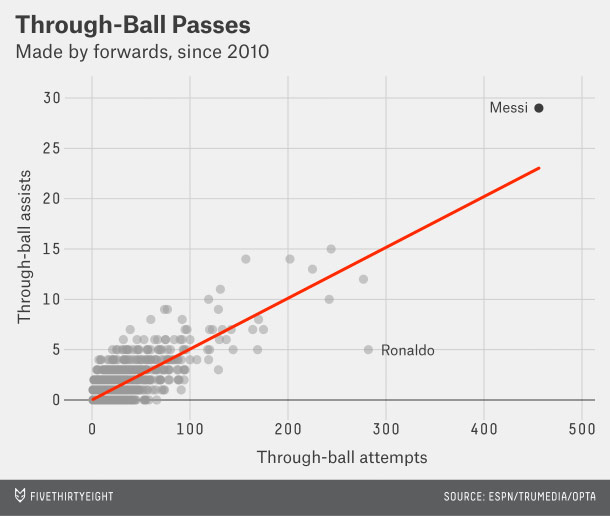
One of my favorite things that I've written about sports is how Lionel Messi rarely dives, which allows him to keep the advantage he has over the defense.
One woman, 17 British accents
Watch actress Siobhan Thompson do 17 different British and Irish accents:
Much better done and more entertaining than this tour of British accents I featured back in April. (via @Atul_Gawande)
The longevity gap
The growing inequality between the rich and poor has become one of the key stories of this era. But while the focus is on money, it's really about something much more basic than that: Life. Americans who are affluent already live about twelve years longer than their poor and working class counterparts. And with new technologies on the way, that gap could widen dramatically. The story of the haves and the have-nots could quickly become a story of the haves and the dead. Aeon's Linda Marsa on The Longevity Gap.
Halt and Catch Fire titles
Speaking of Halt and Catch Fire, the title sequence is pretty awesome:
I am also currently trying (and mostly failing) not to have a giant crush on Mackenzie Davis, who plays crack programmer Cameron Howe on the show, reads Infinite Jest in Brooklyn coffee shops, gets anxious about talking on the phone (me too!), and has recently read The Soul of a New Machine (me too!). Am I wrong to think we'd totes be BFFs?!
Update: The Art of the Title did a feature on the H&CF titles, which includes 55 photos of storyboards. Pretty cool to see the process. (via @ScottIvers)
Update: Halt's opening sequence was nominated for an Emmy in Outstanding Main Title Design!
Scientist biography recommendations
Earlier today I asked my Twitter followers for recommendations for "really good" biographies about scientists. I gave Genius (James Gleick's bio of Richard Feynman) and Cleopatra, A Life (not about a scientist but was super interesting and well-written) as examples of what I was looking for. You can see the responses here and I've pulled out a few of the most interesting ones below:
- Isaac Newton by James Gleick. Gleick wrote the aforementioned Genius and Chaos, another favorite of mine. I tried to read The Information last year after many glowing recommendations from friends but couldn't get into it. Someone suggested Never at Rest is a superior Newton bio.
- The Man Who Loved Only Numbers by Paul Hoffman. I've read this biography of mathematician Paul Erdos; highly recommended.
- Galileo's Daughter by Dava Sobel. I've never read anything by Sobel; I'll have to rectify that.
- Einstein: His Life and Universe by Walter Isaacson. I enjoyed his problematic Jobs biography and I notice that he's written one on Ben Franklin as well.
- Alan Turing: The Enigma by Andrew Hodges.
- American Prometheus by Kai Bird and Martin Sherwin. Bio of J. Robert Oppenheimer, leader of the Manhattan Project. See also: The Making of the Atomic Bomb, one of my favorite books ever.
- Everything and More by David Foster Wallace. I've heard Wallace was bit handwavy with the math in this one, but I still enjoyed it.
- Newton and the Counterfeiter by Thomas Levenson. Newton was a detective?
- The Philosophical Breakfast Club by Laura Snyder. Four-way bio of a group of school friends (Charles Babbage, John Herschel, William Whewell, and Richard Jones) who changed the world.
- The Reluctant Mr. Darwin by David Quammen. How Charles Darwin devised his theory of evolution and then sat on it for years is one of science's most fascinating stories.
- T. rex and the Crater of Doom by Walter Alvarez. Not a biography of a person but of a theory: that a meteor impact 65 million years ago caused the extinction of the dinosaurs.
- Walt Disney by Neal Gabler. Disney isn't a scientist, but when you ask for book recommendations and Steven Johnson tells you to read something, it goes on the list.
- The Man Who Knew Infinity by Robert Kanigel. Bio of brilliant Indian mathematician Srinivasa Ramanujan.
- Edge of Objectivity by Charles Gillispie. A biography of modern science published in 1966, all but out of print at this point unfortunately.
- Galileo at Work by Stillman Drake.
- The Age of Wonder by Richard Holmes.
And many more here. Thanks to everyone who suggested books.
Update: Because this came up on Twitter, some biographies specifically about women in science: The Immortal Life of Henrietta Lacks, Hedy's Folly, On a Farther Shore, Marie Curie: A Life, A Feeling for the Organism, Rosalind Franklin: The Dark Lady of DNA, Jane Goodall: The Woman Who Redefined Man, and Radioactive.
Smarty Pins
Smarty Pins is a Google Maps-based geography quiz...you drop pins on the map to answer questions. You start with a total of 1000 miles and the game subtracts the number of miles you're off by for each answer.

I just spent far too long playing this. Can you beat my score of 39? Also, this reminds me of GeoGuessr, which is a lot more difficult.
The Soul of a New Machine
Inspired by Halt and Catch Fire, I'm re-reading Tracy Kidder's The Soul of a New Machine. I had forgotten how good this book is. Man. The story follows an engineering team at Data General as they attempt to design and build an entirely new minicomputer in the late 1970s. Kidder won a Pulitzer and a National Book Award for this book.
The Atlantic published two lengthy excerpts of the book back in 1981 — Flying Upside Down and The Ultimate Toy — but if those catch your fancy at all, I'd recommend skipping them and just read the book.
One holiday morning in 1978, Tom West traveled to a city that was situated, he would later say guardedly, "somewhere in America." He entered a building as though he belonged there, strolled down a hallway, and let himself quietly into a windowless room. Just inside the door, he stopped.
The floor was torn up; a shallow trench filled with fat power cables traversed it. Along the far wall, at the end of the trench, enclosed in three large, cream-colored steel cabinets, stood a VAX 11/780, the most important of a new class of computers called "32-bit superminis." To West's surprise, one of the cabinets was open and a man with tools was standing in front of it. A technician, still installing the machine, West figured.
Although West's designs weren't illegal, they were sly, and he had no intention of embarrassing the friend who had told him he could visit this room. If the technician had asked West to identify himself, West wouldn't have lied and he wouldn't have answered the question, either. But the moment went by. The technician didn't inquire. West stood around and watched him work, and in a little while the technician packed up his tools and left.
Then West closed the door and walked back across the room to the computer, which was now all but fully assembled. He began to take it apart.
West was the leader of a team of computer engineers at a company called Data General. The machine that he was disassembling was produced by a rival firm, Digital Equipment Corporation, or DEC. A VAX and a modest amount of adjunctive equipment sold for something like $200,000, and as West liked to say, DEC was beginning to sell VAXes "like jellybeans." West had traveled to this room to find out for himself just how good this computer was, compared with the one that his team was building.
Where to stand in solar system
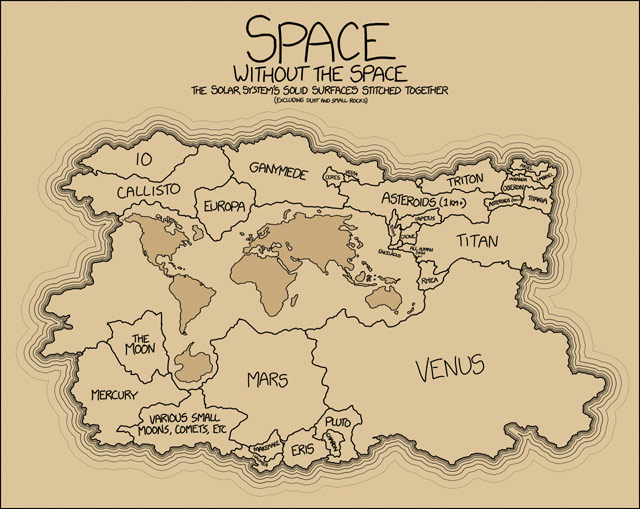
From XKCD, an illustration of the solar system's solid surfaces stitched together. Best viewed large (if only to find the "all human skin" label). Randall Munroe is just the best, isn't he?
Music for Real Airports
Today's jam — ok, not a jam exactly but more like marmalade spread on soft white bread — is Music for Real Airports by The Black Dog.
The title of the album is a play on Brian Eno's Music for Airports:
Airports have some of the glossiest surfaces in modern culture, but the fear underneath remains. Hence this record is not a utilitarian accompaniment to airports, in the sense of reinforcing the false utopia and fake idealism of air travel. Unlike Eno's Music for Airports, this is not a record to be used by airport authorities to lull their customers. The album is a bittersweet, enveloping and enormously engaging listen. It is ambient, but focused. This is not sonic mush, nor adolescent noise. Nor is it a dance album. Much of the raw material of the album was made in airports over the last three years. While on tour, the Black Dog made 200 hours of field recordings, much of which was processed and combined with new music in the airport itself, waiting for the next flight. This vast amount of content has been slowly distilled into a set of particularly evocative pieces of music.
(via the scissors video)
The Putter Togetherer
A person who makes scissors by hand is called a putter, short for putter togetherer. The Putter is a four-minute silent film by Shaun Bloodworth that shows putter Cliff Denton making scissors.
You can order a pair of these handmade scissors at Ernest Wright & Sons; a pair of 6-inch desk scissors are £23, but they come with a lifetime guarantee and I bet you won't find a better pair of scissors anywhere. The wonderful music in that video is by The Black Dog. (via colossal)
Better living through motivational passwords
When faced with a mandatory monthly password change, Mauricio Estrella decided to use it as an opportunity to improve his life.
My password became the indicator. My password reminded me that I shouldn't let myself be victim of my recent break up, and that I'm strong enough to do something about it.
My password became: "Forgive@h3r"
I had to type this statement several times a day. Each time my computer would lock. Each time my screensaver with her photo would appear. Each time I would come back from eating lunch alone.
In my mind, I went with the mantra that I didn't type a password. In my mind, I wrote "Forgive her" everyday, for one month.
I think this strategy might even work with the world's worst password requirements.
Moneyball 2.0
After Michael Lewis wrote Moneyball in 2003 about the Oakland A's, their general manager Billy Beane, and his then-unorthodox and supposedly superior managerial strategy, a curious thing happened: the A's didn't do that well. They went to the playoffs only twice between 2003 and 2011 and finished under .500 four times. Teams like the Red Sox, who adopted Beane's strategies with the punch of a much larger payroll, did much better during those years.
But Beane hung in there and has figured out how to beat the big boys again, with two first place in 2012 & 2013 and the best record in the majors this year so far. Will Leitch explains how.
First, don't spend a lot on a little; spend a little on a lot.
The emotional through-line of Moneyball is Beane learning from his experience as a failed prospect and applying it to today's game. The idea: Scouts were wrong about him, and therefore they'll be wrong about tons of guys. Only trust the numbers.
That was an oversimplification, but distrusting the ability of human beings to predict the future has been the centerpiece of the A's current run. This time, though, the A's aren't just doubting the scouts; they're also skeptical that statistical analysis can reliably predict the future (or that their analysis could reliably predict it better than their competitors). Instead, Beane and his front office have bought in bulk: They've brought in as many guys as possible and seen who performed. They weren't looking for something that no one else saw: They amassed bodies, pitted them against one another, were open to anything, and just looked to see who emerged. Roger Ebert once wrote that the muse visits during the act of creation, rather than before. The A's have made it a philosophy to just try out as many people as possible — cheap, interchangeable ones — and pluck out the best.
DFW, on the cusp of literary stardom
Just after Infinite Jest was published, David Foster Wallace came to Boston and did a radio interview with Chris Lydon. Radio Open Source recently unearthed that interview, probably unheard for the past 18 years, and published it on their site.
When I started the book the only idea I had is I wanted to do something about America that was sad but wasn't just making fun of America. Most of my friends are extremely bright, privileged, well-educated Americans who are sad on some level, and it has something, I think, to do with loneliness. I'm talking out of my ear a little bit, this is just my opinion, but I think somehow the culture has taught us or we've allowed the culture to teach us that the point of living is to get as much as you can and experience as much pleasure as you can, and that the implicit promise is that will make you happy. I know that's almost offensively simplistic, but the effects of it aren't simplistic at all.
